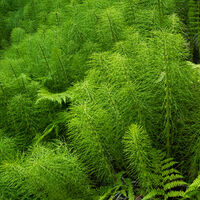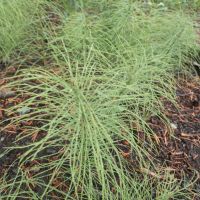horsetails
genus Equisetum
Member of
horsetail family (family Equisetaceae)
horsetails (order Equisetales)
horsetails (subclass Equisetidae)
ferns (class Polypodiopsida)
Except for historical records that I'm ignoring, there are no other wild species of this genus in the bay area.
Leaves are extremely small, in a whorl from stem nodes, and fused into an appressed sheath. The number of sheath teeth equals the number of leaves.
Branches are much longer, also in a whorl from stem nodes. Photosynthesis generally takes place in the stem and branches.
Some species make separate sterile and fertile stems. Sterile stems are green, but fertile stems may not be.
Key features:
- basal internode of branch < or > subtending nodal sheath
- number of teeth per sheath
- branch hollow or solid
Separate sterile and fertile stems
Equisetum telmateia
- sterile stem 30–100 cm tall, light green, regularly branched
- basal internode of branch < subtending nodal sheath [significantly?]
- branch is solid, has 4–5 grooved ridges lengthwise
- [do these look like 4–5 pairs of ridges?]
- sheath teeth 14–28
- fertile stem 17–45 cm tall, brown, unbranched, fleshy
- very common
Single type of stem
marsh horsetail
Equisetum palustre
- stem 20–80 cm tall, green
- basal internode of branch < subtending nodal sheath [significantly?]
- branch is hollow, has 4–6 rounded ridges lengthwise
- sheath teeth 5–10
- very rare
Toxicity of foxtail, horse willow, horsetail, mexican horsetail, rush (Equisetum spp.):
4 – Ingestion of these plants, especially in large amounts, is expected to cause serious effects to the heart, liver, kidneys or brain. If ingested in any amount, call the poison center immediately.
2 observed taxons / 4 unobserved taxons / 2 keys
Locations: Months: For more details, use advanced search.
Chris’s observations: 26 (16 are research grade)
Taxon info: iNaturalist – Calflora – Jepson eFlora – FNA
Bay Area species: iNaturalist – Calflora

